Article
Urologists helping drive male-specific centers
Multidisciplinary men’s health centers, rooted at hospitals, academic centers, and some private clinics, have expanded in the last few years and are meeting an important need in medicine, say key figures in these centers. Urologists are helping to drive these clinics’ success.
National Report-Multidisciplinary men’s health centers, rooted at hospitals, academic centers, and some private clinics, have expanded in the last few years and are meeting an important need in medicine, say key figures in these centers. Urologists are helping to drive these clinics’ success.
COMMENTARY: 'Men's health' more than a marketing ploy
True men’s health centers do more than fill out prescriptions for testosterone, according to the experts we interviewed. To treat erectile dysfunction or low testosterone in isolation is irresponsible medicine, they said.

Dr. Lamm“Men’s health is primarily viewed below the waistline-prostate issues, sexual health issues, fertility issues. And I think what we’re starting to appreciate is that there are a lot of problems that really are above the waistline that are contributing to conditions below the waistline,” said Steven Lamm, MD, an internal medicine physician and medical director of the Preston Robert Tisch Center for Men’s Health at NYU Langone Medical Center, New York. “There’s a movement and a trend toward a global care of men and trying to suggest that men really need to be taken care of in a holistic way. The urologic component really should be a component, but not the entire picture.”
One of the hurdles to providing comprehensive health care for men, however, is that men are far less likely than women to go to the doctor. Urology could be the key to capturing this evasive gender. When men do visit a physician, it’s often a urologist they see because urinary tract symptoms, erectile dysfunction, or infertility drive them to seek health care, according to James M. Hotaling, MD, MS, assistant professor of surgery (urology) and co-director of the Center for Reconstructive Urology and Men’s Health, University of Utah Health Care, Salt Lake City.
“What we’re moving toward is a model where these guys come in and essentially get all or most of their health care needs met in one visit,” Dr. Hotaling said.
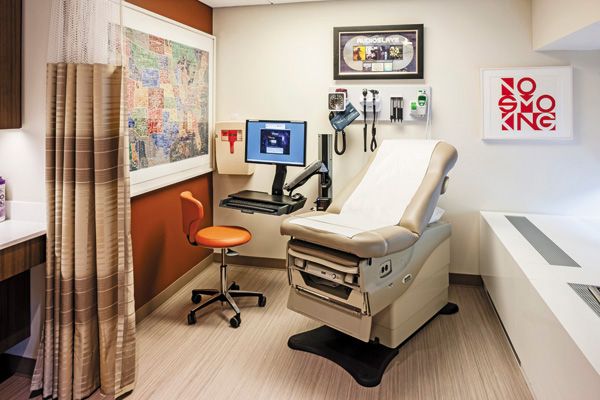
Artwork is on display in an exam room at the Preston Robert Tisch Center for Men’s Health at NYU Langone Medical Center. (Photo courtesy of Rene Perez/NYU)
No shot clinics here
This model differs from the doc-in-a-box type of clinics described in Time magazine’s recent cover article, “Manopause?! Aging, insecurity and the $2 billion testosterone industry” (July 31, 2014). Multidisciplinary collaboration is key for the success and credibility of a men’s health center, according to Hunter Wessells, MD, professor and chair of urology at the University of Washington School of Medicine and staff member of the UW Medicine Men’s Health Center, Seattle.
RELATED: Five must-haves for a successful men’s health center
“Not all men’s health centers are the same. Some are testosterone mills that are run by people with very little training in urologic diseases and are likely to be non-specialists. And some of them are very committed to improving the health of men,” Dr. Wessells said.
Dr. Hotaling says he sees at least one patient a week who is infertile because he has been inappropriately placed on testosterone at one of the “shot clinics.”
“A lot of these testosterone clinics don’t even see these patients. It’s all done over the Web. And they charge them about $400 a month for their testosterone and for monitoring their therapy. What’s difficult about testosterone is everyone will feel better if you put them on it. So it really requires some expertise to be able to ascertain who should be on it and shouldn’t be on it,” Dr. Hotaling said.
UW Medicine looked at the formation of its men’s health center as a healthy alternative to testosterone and erectile dysfunction mills, according to Thomas J. Walsh, MD, associate professor of urology and director of the UW Medicine Men’s Health Center.
“Our model of delivering care is not a financial or mercantilistic model; it’s more of a complete care model,” Dr. Walsh said.
Models vary

Dr. PelmanRichard S. Pelman, MD, clinical professor of urology at the University of Washington and a course director of the AUA’s postgraduate course on male health, said he has introduced the course by asking attendees what men’s health represents to them.
“To some, men’s health represents reproductive health; to others, it may represent sexual health; to others, it may represent prostate health. It may be packaged into a longevity clinic and, recently, it may represent a testosterone replacement therapy clinic,” Dr. Pelman said.
The concept of the faculty involved in the AUA course and the original AUA Ad Hoc Committee on Male Health was much more encompassing, according to Dr. Pelman.
“The concept of male health was to help urologists expand from the traditional model of directed evaluation and therapy of the GU organ to an expanded concept of systemic disease as it impacts that organ and how the GU issue may impact systemic disease,” he said. “The urologist role would expand to a ‘recognition and refer’ role as issues were identified. The obvious example is cardiometabolic disease and sexual health.
“Urologists should no longer limit their involvement to evaluation of ED and treatment. They must alert the patient as to the association of cardiometabolic disease and ED, and if the patient has not visited a medical provider recently, they need to at a minimum make that man an appointment with a primary care practice.”
While even this men’s health center model varies from center to center, there is a consistent focus on male-specific multidisciplinary care, with the goal of streamlining men’s health care experiences.
Some centers act more as portals to care, focusing on low testosterone and erectile dysfunction, but screening men for other health issues and having in place a referral network. Others are more comprehensive.
Commonly, men’s health centers are run by internists or urologists-sometimes both. Often, other specialists keep hours at the center.

The reception area at the University of Washington’s UW Men’s Health Center offers an inviting entrance. (Photo courtesy of Clare McLean/UW Medicine)
New to the scene
All are fairly recent pioneers into this model of care. The first multidisciplinary men’s health center to open in the U.S. was the Men’s Health Center at The Miriam Hospital, Providence, RI, which opened in 2008. The model of care there is in-depth management of male sexual dysfunction, exploration of relationships to any potential incident coronary artery disease with a medical workup, a cardiometabolic evaluation, and stratification of patients at risk for cardiovascular events, including heart attack and stroke, according to Martin Miner, MD, co-director, Men’s Health Center at The Miriam Hospital and clinical associate professor of family medicine and urology at Brown University’s Warren Alpert Medical School.
RELATED: Three key design elements for a successful men’s health center
Dr. Miner, an internist with urologic training, co-directs the clinic with urologist Mark Sigman, MD. The center is a portal for men who might need additional care by a cardiologist or other physician, Dr. Miner said.
“We have two full-time internal medicine specialists, a PA, three part-time urologists, and two psychologists (one part-time, one full-time). We have a physical therapist,” Dr. Miner said.
The men’s health center at the University of Utah has two urologists who work one day a week at the clinic, along with two (soon to be three) physician assistants.
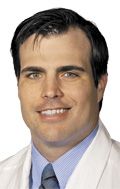
Dr. Hotaling“We’re hiring a sexual therapist. Then we have cardiologists and primary care and some sleep medicine doctors, who we work with and refer to. We also have a nutritionist and a few other people who we work a lot with to optimize the care for these men,” Dr. Hotaling said.
While some of those doctors are not on-site, they are part of the University of Utah’s outpatient clinic, which houses the men’s center, he says.
“If someone really needs to see a primary care doctor, I can literally walk them down the hall and get them in that day,” Dr. Hotaling said.
Dr. Hotaling says the men’s health center is moving toward a process where patients are screened on the phone for which doctors to see first, then booked for those appointments in one visit, he says.
Opened for more than a year, the UW Medicine men’s health center is a similar model, directed by a urologist, but including urologists and general practitioners, according to Dr. Wessells.
“Our model does not cover the whole spectrum of cardiovascular disease, sleep disorders, and sees itself as a portal entry into health care for men. We focus on male reproductive, sexual, and urinary problems and work to link men both with other specialists and with primary care providers,” Dr. Wessells said.
Next: "One entry system; one exit system"
NewYork-Presbyterian/Weill Cornell Medical Center in New York opened its Iris Cantor Men’s Health Center in July 2012, according to Steven A. Kaplan, MD, the center’s director.
“Traditionally, men’s health models were run, at least in the academic world, by internal medicine people,” said Dr. Kaplan, who is professor of urology at Weill Cornell Medical College. “I think it was the first time at Cornell that we were able to coalesce different departments-urology and medicine-under one banner. It demonstrated that you could actually bring in multiple different stakeholders under one roof. One entry system; one exit system.”
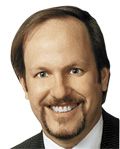
Dr. KaplanDr. Kaplan says his vision for a men’s health center is a one-stop center for dealing with the most common things that men who access the health care system want. He says this includes urologic health, sexual health, urinary issues, cancer screenings, cardiac health, issues related to obesity and diabetes, sports medicine, psychological health, diet, and exercise.
“We don’t do all of that. But if I had my wish list, it would include these areas to handle it all in one center,” Dr. Kaplan said.
NYU’s men’s health center has 24 clinicians on staff, with expertise in internal medicine, pulmonary medicine, orthopedics, psychology, gastroenterology, rheumatology, otolaryngology, dermatology, psychiatry, and more. Four of the doctors there are urologists.
Some of the more established women’s centers can make good models for men’s centers. NYU created its male health center, which opened in January 2014, based on NYU’s Tisch Center for Women’s Health, developed years earlier, according to Dr. Lamm.
Attaching the men’s health concept to a practice or clinic is more than a name or an advertising and marketing tool, according to Dr. Kaplan. The concept of holistic care means that a urologist who sees an obese patient with sexual dysfunction will address diabetes, lipidemia, and hypertension, and might walk the patient down the hall to visit with the center’s internist or cardiologist, if needed.
“It’s a philosophy that we think beyond our own specialties,” Dr. Kaplan said.
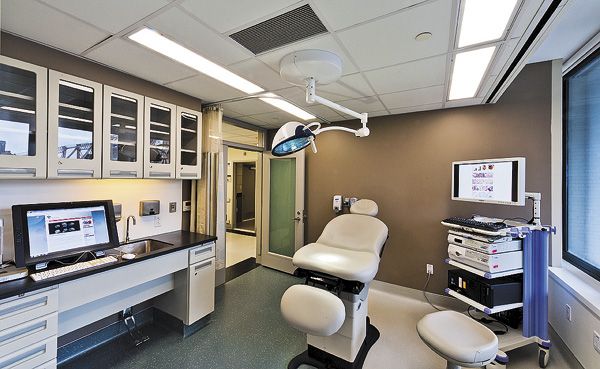
An exam room at the Iris Cantor Men’s Health Center at NewYork-Presbyterian/Weill Cornell offers a sleek, high-tech look. (Photo courtesy of Walter Dufresne/NewYork-Presbyterian Hospital)
Key components
Men want one-stop-shopping, those who direct centers say.
“If you ask a man to go across the street to give blood and urine, he’d rather pee in his pants than have to go across the street,” Dr. Lamm said. “You have to make it easy for these guys. I’ve said if a man comes to you with a spear in his head, you don’t take the spear out right away until you’ve measured his blood sugar and blood pressure because if you take the spear out, he’s going to leave.”
A male-centered clinic should know how to work with men.
“You have to understand how to deal with men,” Dr. Lamm said. “We do not criticize men for their obesity, drinking, or smoking. We’re here to assist them and provide a safe place and a place where we can advise them about how to get healthier, more competitive, and how to proceed in life.”
Expertise is important. For example, UW Medicine assembled a group of experts not only in their respective specialties but also in men’s health, according to Dr. Walsh.
Man cave-like
These experts say men’s health centers should have separate waiting rooms that look inviting to men.
The University of Utah center is decorated in darker colors and offers flat-screen televisions not only in the waiting room, but also in the procedure rooms. A selection of magazines that men like to read is a must, according to Dr. Hotaling.
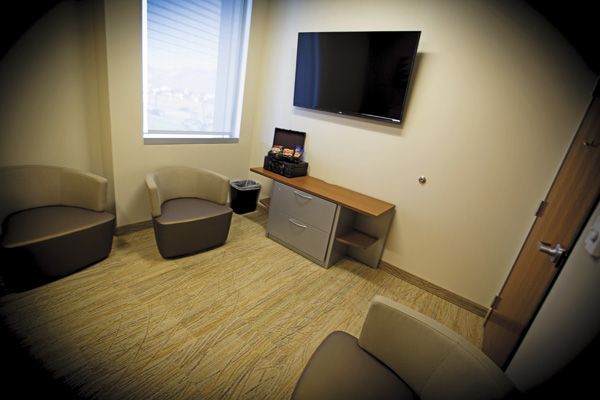
The University of Utah’s men’s health clinic center features flat-screen TVs in both the waiting room and procedure rooms. (Photo courtesy of University of Utah Health Care)
“We tend to have a sports channel on in [the waiting room],” Dr. Wessells said. “During the World Cup, there were a lot of people watching the game in there.”
UW Medicine is among the clinics that’s isolated, according to Dr. Walsh.
“We are not housed within the general urology clinic that sees women with incontinence or men with prostate cancer. Rather, we are a clinic that is very specific to men’s health conditions, like ED, hypogonadism, reproductive failure, BPH, and issues that arise after cancer treatment,” Dr. Walsh said. “We needed a unique physical space that was defined by walls as a men’s health center.
“And that’s exactly what we did. We created an environment that was inviting and masculine. It was staffed with people who were accustomed to the unique needs of men and had all the accoutrements that make men comfortable.”
Selling the concept
Selling the concept to the institution is critical, center directors say.
One important selling point is that a men’s health center drives other referrals and business for hospitals, academic centers, and multispecialty group practices.

Dr. WessellsAlthough UW is a nonprofit organization, Dr. Wessells says the men’s center there has exceeded expectations in number of visits.
“We’re bringing in new business to the department and to the university,” Dr. Wessells said. “It’s a successful model.”
While each of these clinics has been financially successful, according to those we interviewed, garnering patients takes marketing and outreach, Dr. Hotaling says.
“Most of your patients are not coming in from referrals because men don’t see doctors,” he said. “So we have a pretty good marketing team that helps us do outreach on the Web and on the news. We’re trying to differentiate ourselves, mainly saying that we can offer comprehensive care, with this as a portal entry. No matter what your urologic or other issue is, we have a team of experts in place to address it.”
One of the pillars of UW Medicine’s marketing approach was to provide outreach and education, and garner community input, according to Dr. Walsh.
“We did this a number of different ways. We delivered community health talks that were supported by the men’s health center, where we would bring men in to learn about their conditions,” Dr. Walsh said. “We also did things that were a little more complicated and have really been beneficial. For example, we have assembled a community advisory board for men’s health. Among these men, some had men’s health conditions, but others were simply community leaders. We asked them: What should we be doing? What would you want to see in a men’s health center? What services should we offer? How should we do outreach?”
Not all centers have the financial backing to do full-blown marketing campaigns. That’s not a problem, according to Dr. Miner.
“Based on the hospital’s figures, we’re now moving to net receipts (this is different than charges because you get about 50% of your receipts), and we’ve grown in numbers. We have had little marketing at all. It’s largely word of mouth,” Dr. Miner said.
According to Dr. Miner, half of The Miriam Hospital center’s patients are self-referred. The others are the result of grand rounds that Dr. Miner and another physician from the center give to different departments-cardiology, pulmonology, infectious disease, psychiatry, and general internal medicine-about once every 2 years.
“Patients are referred from within. They come to us for a short period of time-about three visits. Then, they’re referred back to their primary care physician always with evaluation and recommendations for their care, including their sexual dysfunction. This includes increased management of their risk factors for cardiovascular disease, including diet,” Dr. Miner said.
Words of wisdom
Urologists and other physicians should see how the concept of a men’s health center fits into their individual health care environments-whether those are hospitals, academic centers, or multispecialty groups, Dr. Wessells said.
“For example, when we started talking about this, there were primary care physicians who were worried that we were going to take business from them. So I think you need to understand the context you’re working in and how best to collaborate,” Dr. Wessells said.
It is important to refer back to the community primary care physicians, according to Dr. Miner.
“The biggest threat that we had when we started the center was not from urologists, because they know that they don’t know medicine, frankly,” he said. “The biggest threat was, what value do we add to the primary care clinicians in helping co-manage their patients? They may feel that they do just fine. But they honestly don’t have the time to sit down and spend an additional 40 minutes for an evaluation of a patient with sexual dysfunction or low testosterone.”
The big picture: Gender branding
Dr. Kaplan said that he often gets calls from others around the country who want to build comprehensive men’s health centers. The men’s health brand is growing. Health centers, private practitioners and groups, and academic centers that capitalize on gender-specific medicine will win because patients will demand it, according to Dr. Kaplan.
“I think it’s great because it’s a statement that men matter,” Dr. Lamm said.
For the brand to continue successfully, however, it will require that more clinicians become trained in men’s health, according to Dr. Miner.
“Finding an internist or a person with knowledge in medicine, whether that’s a cardiologist or an endocrinologist, who is willing to learn about urology is rare. I was trained as a family physician, but I belong to the AUA and the Sexual Medicine Society of North America. I’ve been on the board of the SMSNA. There are very few non-urologists who achieve that,” Dr. Miner said. “If we want this kind of model to continue, we have to have a fellowship in male andrology or broader men’s health, so we can train younger physicians in this field. Right now the only fellowship in men’s health that exists is for urologists.”UT
Subscribe to Urology Times to get monthly news from the leading news source for urologists.
















